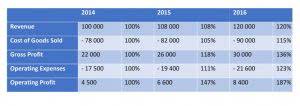
Customers often change their service level and add or remove extra services, causing MRR for that customer to change. For example, under a cash basis of accounting, Company ABC invoices a client for an annual, one-year subscription for $12,000. Company ABC records the entire $12,000 in a single month in the financial statements. saas accounting rules Figuring out nexus—the connection between your business and a state that triggers sales tax obligations—can be complicated.
Step 5: Monitor & Analyze Metrics

As a growing company, you will refine your software, adding more capabilities for customers to explore. It is only natural to increase your prices to cover these added costs and to increase profit margins. Generally, SaaS companies will include terms for price changes in their contracts, upping their fees incrementally. To stay compliant, you always should recognize revenue evenly over the life of the contract, even if that means at the beginning of the contract you are recognizing more revenue. SaaSOptics is a subscription management integration targeted at B2B SaaS companies. It is touted for its ability to categorize customer contracts and transfer essential financials to your accounting system.
- Cash-basis accounting recognizes revenue and expenses when cash is received or paid.
- The alternative for most other countries is the International Financial Reporting Standards (IFRS), which is regulated by the International Accounting Standards Board (IASB).
- This means revenue is recognized over the subscription period, not just when the cash comes in.
- While intricate and unique, SaaS accounting is integral to the financial health and transparency of a SaaS business.
- Burn rate measures the rate at which a company consumes its cash reserves to cover expenses.
Emerging Trends in SaaS Financial Management
If you’re a SaaS business, getting your accounting right is the foundation for sustainable growth. Want to learn more about how HubiFi can help streamline your SaaS accounting? Every month, SaaS accounting teams have to review accrued expenses and revenue to ensure they’re booked properly in the GL. And on the first of the next month, you have to reverse the accrual to maintain accurate records for the following period. But it’s notoriously tedious and difficult to manually review all accruals and ensure records are accurate when you generate financial statements. One thing that’s unique to SaaS accounting is how much time and attention you have to spend pulling data together from customer contracts.

Reduced Cost

For SaaS companies, revenue is recognized when the customer pays for the subscription and expenses when payments are made to vendors or service providers. For SaaS businesses, deferred revenue is common due to subscription models. Recording this revenue accurately ensures financial statements reflect actual service fulfillment.
SaaS Accounting Guide: Best Practices & Principles
Focus on metrics like Monthly Recurring Revenue (MRR), Annual Recurring Revenue (ARR), Law Firm Accounts Receivable Management Customer Acquisition Cost (CAC), Customer Lifetime Value (CLV), and churn rate. These metrics provide insights into your revenue streams, customer acquisition efficiency, and customer retention, giving you a comprehensive view of your business’s financial health. With subscription-based services, you’re often paid upfront for a service delivered over time. Think of it like a prepaid gift card—the store doesn’t count it as revenue until the card is used.
Tax Acts

If these metrics aren’t accurate or are poorly reported, you won’t be able to access this kind of capital. ASC 606 is the standard accounting guidelines developed jointly by the FASB and International Accounting Standards Board (IASB). At any moment, executives or team members may own public or private stock in any of the third party companies we mention. Our account management team is staffed by CPAs and accountants who have, on average, 11 years of experience. We recommend using an existing financial model template as a base instead of starting from scratch.
Essential Metrics for a Healthy SaaS Business
A deferred revenue account and accounts receivable are essential to keep SaaS revenue organized and easy to forecast. SaaS Accounting refers to the specific accounting trial balance practices and processes applied to Software as a Service (SaaS) businesses. It focuses on managing and reporting the financial activities and transactions unique to a SaaS business.